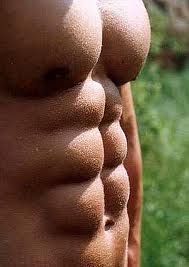 The cultural arena of our body is a fascinating one.
The cultural arena of our body is a fascinating one.
We have so many compensatory patterns due to the way we look and feel.
We tuck our pelvis because we think our butt is too big, we hunch our shoulders to hide our breasts or lean over constantly because we don’t like being tall.
There are many more to add to this list but I am really fascinated by the desire for six pack abs. Our society lives in worship of the sit up or crunch, thinking it is an express train to beauty.
The rectus abdominus is a pair of muscles runs up and down connecting at the pubis at its base and the sternum and three ribs at its top.
These are the muscles we refer to as the “six pack”.
The body has interesting and different ways of compensating for dilemmas of length and space.
The length of span between the pelvis and the ribcage is really too big for one long muscle to provide support. As a result we have tendinous insertions that fall between what are actually ten small muscles. We actually build ten packs but we tend to see six of them.
This pack is formed when we make these individual muscles big enough so that they essentially pop out from the tendons that surround them.
Muscle is designed to stretch while tendons are not. While this might look good, I’d like to take a moment to explain the nature of what is happening to your muscle.
Skeletal muscle is made up of thousands of cylindrical muscle fibers often running all the way from the top of a muscle to the bottom.
The fibers are bound together by connective tissue through which run blood vessels and nerves.
Blood flows through muscles, passing through and around the endless number of fibers that make up an individual muscle.
The way we build muscle mass is by creating micro tears in the muscle fibers and as they heal or repair the body overcompensates in a way, replacing the damaged tissue and adding more, for protection against further damage.
As we continue to build a muscle, the fibers need to have somewhere to go and they begin layering down on top of one another.
As more mass develops the layering becomes denser. At a certain point there will very little room, if any, between the fibers as the muscle continues to build.
When our muscles are truly large and hard the density of muscle fibers will begin to inhibit the flow of blood and oxygen through the muscle, which can lead to trouble down the road.
***
